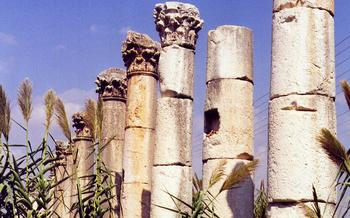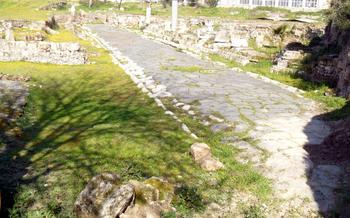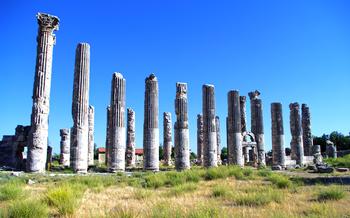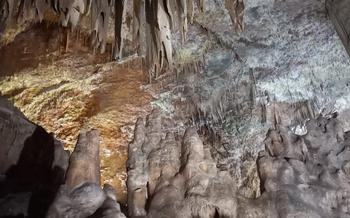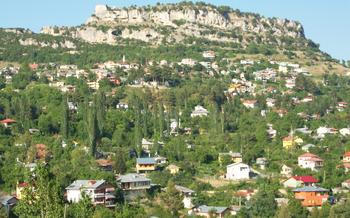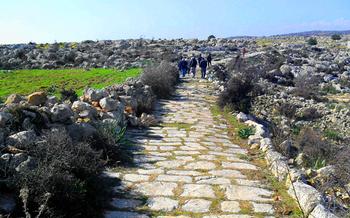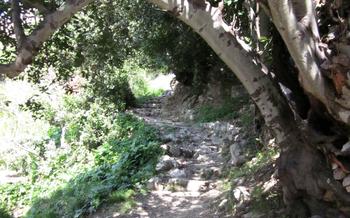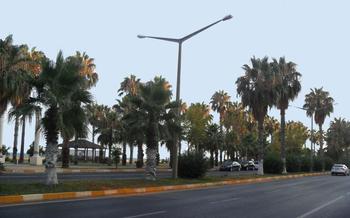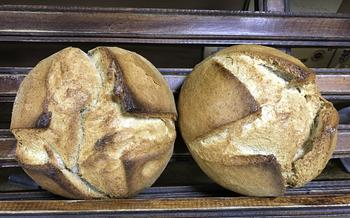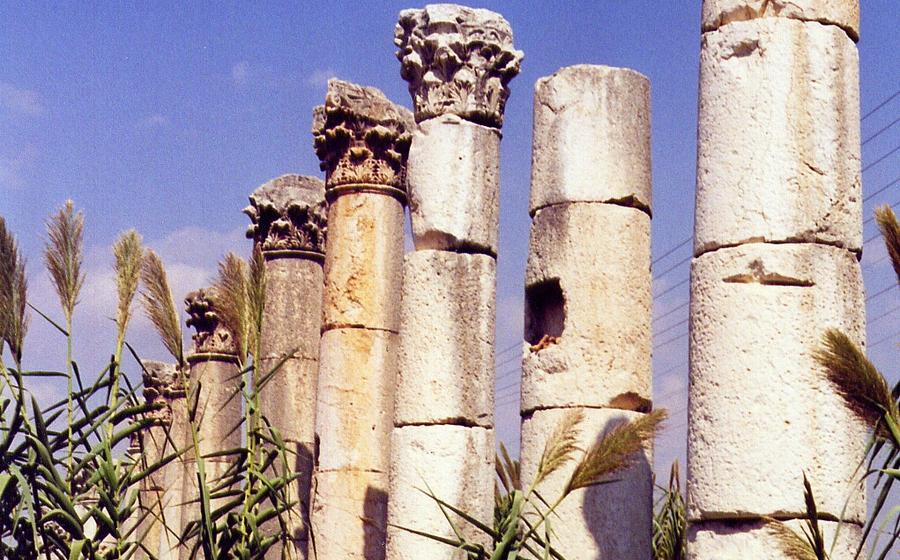
Soli Pompeiopolis Ancient City
- Soli Pompeiopolis Ancient City: A Historical Gem in Mersin
- Exploring the Ruins: A Journey Through Time
- Unveiling the Mosaics: Masterpieces of Ancient Art
- The Aqueduct: A Marvel of Engineering
- The City Walls: Guardians of Soli Pompeiopolis
- The Temple of Zeus: A Sacred Sanctuary
- The Theater: A Stage for Ancient Performances
- The Gymnasium: A Place for Physical Training
- The Baths: Relaxation and Hygiene in Ancient Times
- The Harbor: A Gateway to Trade and Commerce
- The Museum: A Treasure Trove of Ancient Artifacts
- Local Cuisine: Tantalizing Flavors of Mersin
- Nearby Attractions: Exploring Beyond Soli Pompeiopolis
- Ancient Sites and Landmarks
- Natural Wonders and Scenic Spots
- Day Trips and Excursions
- Planning Your Itinerary
- Insider Tip: Unveiling Hidden Gems
Soli Pompeiopolis Ancient City: A Historical Gem in Mersin
Soli Pompeiopolis, an ancient city nestled along the picturesque Mediterranean coast of Mersin, Turkey, stands as a testament to the rich history and cultural heritage of the region. Founded in the 7th century BC by Greek colonists, the city flourished as a major port and trading center, becoming a melting pot of diverse cultures and civilizations. Soli Pompeiopolis reached its peak during the Roman period, when it was renamed Pompeiopolis in honor of the Roman general Pompey the Great. Today, the ruins of this once-thriving city offer a glimpse into the grandeur and complexity of ancient life, inviting visitors to embark on a journey through time.
Located approximately 8 kilometers west of the modern city of Mersin, Soli Pompeiopolis is easily accessible by car or public transportation. The best time to visit is during the shoulder seasons (spring and autumn), when the weather is pleasant and the crowds are smaller. To make the most of your visit, plan to spend at least half a day exploring the ancient city's many attractions. Before you go, be sure to wear comfortable shoes, bring water and sunscreen, and consider hiring a local guide to provide insights and historical context.
Exploring the Ruins: A Journey Through Time
Strolling through the ruins of Soli Pompeiopolis is akin to embarking on a journey through time. The ancient city is a treasure trove of remarkably preserved landmarks and attractions that provide a glimpse into the lives and culture of its former inhabitants.
The Amphitheater: History, Architecture, and Significance
Among the most impressive structures within Soli Pompeiopolis is the grand amphitheater. Built around the 2nd century AD, this magnificent venue once hosted gladiatorial contests, theatrical performances, and other spectacles that captivated audiences. The amphitheater's well-preserved seating tiers, stage, and intricate architectural details offer a glimpse into the grandeur of ancient entertainment.
The Agora: Marketplace, Social Center, and Political Hub
The agora, or marketplace, was the bustling heart of Soli Pompeiopolis. This vast open space served not only as a center for trade and commerce but also as a social and political hub. Here, residents gathered to buy and sell goods, exchange news, and participate in civic affairs. The agora's colonnaded walkways, shops, and public buildings attest to its importance as a focal point of ancient urban life.
The Necropolis: Tombs, Burial Rituals, and Funerary Art
Located outside the city walls, the necropolis, or cemetery, provides insights into the burial customs and beliefs of Soli Pompeiopolis's inhabitants. Elaborate tombs and sarcophagi, adorned with intricate carvings and inscriptions, reveal the reverence with which the ancients treated their dead. The necropolis also offers a glimpse into the social hierarchy of the city, as the size and ornamentation of tombs often reflected the status and wealth of the deceased.
Unveiling the Mosaics: Masterpieces of Ancient Art
Soli Pompeiopolis is home to an exceptional collection of mosaics that stand as testaments to the artistry and craftsmanship of ancient civilizations. These intricate and colorful artworks adorn the floors of various buildings throughout the city, captivating visitors with their beauty and historical significance.
One of the most remarkable mosaics is located in the House of the Orpheus Mosaic. This stunning masterpiece depicts the mythical figure of Orpheus, surrounded by a menagerie of animals, including lions, tigers, bears, and birds. The vivid colors and lifelike details of the mosaic bring the scene to life, inviting viewers to immerse themselves in the enchanting world of ancient mythology.
Another highlight is the mosaic in the House of the Gladiator Mosaic, which showcases a fierce battle between a gladiator and a wild beast. The intricate portrayal of the figures, the dynamic composition, and the expressive faces convey the intensity and drama of the fight, offering a glimpse into the world of ancient Roman entertainment.
Beyond their artistic value, the mosaics of Soli Pompeiopolis provide valuable insights into the culture, beliefs, and daily life of the ancient inhabitants. They depict mythological scenes, religious rituals, hunting expeditions, and everyday activities, offering a window into the past and shedding light on the social, cultural, and economic aspects of ancient society.
The Aqueduct: A Marvel of Engineering
Soli Pompeiopolis boasts an impressive aqueduct system that once supplied the city with a steady flow of fresh water. This remarkable feat of engineering, constructed during the Roman period, stands as a testament to the ingenuity and resourcefulness of ancient civilizations. The aqueduct stretched for several kilometers, channeling water from distant springs and reservoirs into the heart of the city.
Constructed using stone and mortar, the aqueduct consisted of a series of arches and channels that gently sloped downwards to maintain a consistent water flow. The system incorporated sedimentation tanks and filtration chambers to ensure the purity of the water before it reached the city's fountains, baths, and domestic dwellings. The aqueduct not only provided a vital resource for the city's inhabitants but also played a crucial role in maintaining public health and sanitation.
This marvel of ancient engineering reflects the advanced knowledge and expertise of Roman engineers in water management and hydraulics. The aqueduct system not only facilitated the growth and prosperity of Soli Pompeiopolis but also served as a model for future civilizations in the region. Today, the remains of the aqueduct stand as a reminder of the ingenuity and perseverance of our ancestors, who left behind a legacy of engineering marvels that continue to inspire and amaze.
The City Walls: Guardians of Soli Pompeiopolis
The ancient city of Soli Pompeiopolis was encircled by a formidable system of defensive walls, a testament to the city's strategic importance and determination to protect its inhabitants from invaders.
Built with meticulous precision, the walls stood tall and sturdy, showcasing the advanced engineering skills of the ancient builders. Constructed using large blocks of stone, the walls were designed to withstand the rigors of time and potential attacks.
Strategically positioned gates and towers adorned the city walls, serving as entry points and vigilant watchtowers. These gates allowed controlled access to the city, while the towers provided elevated vantage points for sentinels to keep a watchful eye on the surrounding landscape, ensuring the safety of the city's residents.
The city walls played a pivotal role in safeguarding Soli Pompeiopolis from external threats. They acted as a robust barrier, deterring potential invaders and providing a sense of security to the city's inhabitants.
Today, the remnants of these once-imposing walls stand as a testament to the ingenuity and resilience of the ancient city's builders. Restoration efforts have been undertaken to preserve this significant vestige of Soli Pompeiopolis's rich history, allowing visitors to appreciate the grandeur and strength of this defensive system.
The Temple of Zeus: A Sacred Sanctuary
Amidst the ruins of Soli Pompeiopolis, the Temple of Zeus stands as a testament to the city's religious devotion and architectural prowess. Dedicated to the king of the Greek gods, this temple was a sacred sanctuary where ancient inhabitants worshipped and paid homage to Zeus.
The temple's imposing presence is a sight to behold, with its grand columns, intricate carvings, and well-preserved structure. Its architectural features showcase the mastery of ancient Greek craftsmanship, incorporating elements such as Doric columns, pediments adorned with sculptures, and a spacious interior designed for ceremonial gatherings.
Within the temple, visitors can envision the religious rituals and ceremonies that once took place. Devotees would gather to offer prayers, perform sacrifices, and seek divine guidance from Zeus. The temple's sacred atmosphere and awe-inspiring design created a profound sense of reverence and spirituality among the ancient inhabitants of Soli Pompeiopolis.
The Temple of Zeus holds immense significance for understanding ancient Greek mythology and religious practices. It provides valuable insights into the beliefs, rituals, and customs of the people who once called this city home. Exploring this sacred sanctuary is a journey into the heart of ancient Greek religion, offering a glimpse into the spiritual world of Soli Pompeiopolis.
The Theater: A Stage for Ancient Performances
Within the ancient city of Soli Pompeiopolis, nestled amidst the ruins and remnants of the past, stands a well-preserved theater, a testament to the city's rich cultural heritage. This architectural marvel, constructed in the Hellenistic period, served as a vibrant stage for a variety of performances that entertained and enthralled the inhabitants of Soli.
The theater, with its carefully designed acoustics and seating arrangements, allowed for an immersive and engaging experience for audiences. It accommodated a significant number of spectators, who gathered to witness theatrical performances, musical concerts, and even religious ceremonies. The stage, adorned with intricate carvings and sculptures, provided a platform for actors, musicians, and performers to showcase their talents.
One can almost imagine the atmosphere of excitement and anticipation as the curtains rose, revealing a world of drama, comedy, and spectacle. The actors, adorned in elaborate costumes, brought to life tales of mythology, history, and everyday life, captivating the hearts and minds of the audience. The theater served as a gathering place, where people from all walks of life came together to share in the communal experience of live entertainment.
Today, the theater stands as a reminder of the vibrant cultural life that once flourished in Soli Pompeiopolis. Its impressive architecture and well-preserved condition make it a must-visit attraction for anyone interested in exploring the ancient world. Whether you're a history buff, a theater enthusiast, or simply someone who appreciates the beauty of ancient architecture, the theater at Soli Pompeiopolis is sure to leave a lasting impression.
The Gymnasium: A Place for Physical Training
In ancient Greek and Roman culture, physical fitness and training were highly valued. The gymnasium was a vital institution dedicated to promoting physical education and the development of athletic skills. Within the ancient city of Soli Pompeiopolis, the gymnasium served as a crucial gathering place for individuals to engage in various forms of exercise and recreational activities.
The gymnasium typically comprised several facilities and features designed to facilitate physical training. These included a palestra, which was an open courtyard used for wrestling and other sports, as well as a dedicated wrestling area. Additionally, the gymnasium often featured baths, allowing individuals to cleanse and refresh themselves after their workouts.
Beyond its role in promoting physical fitness, the gymnasium held significant social and cultural importance. It served as a meeting point for individuals from all walks of life to engage in discussions, socialize, and foster a sense of community. The gymnasium was not merely a place for physical training but also a hub for intellectual and social interaction.
Participating in athletic activities at the gymnasium was not only beneficial for physical well-being but also played a crucial role in shaping the character and discipline of individuals. Through rigorous training and friendly competition, participants learned the values of perseverance, teamwork, and sportsmanship. The gymnasium, therefore, served as a vital institution that contributed to the overall development and well-being of individuals in ancient Soli Pompeiopolis.
The Baths: Relaxation and Hygiene in Ancient Times
In ancient Roman culture, bathing held immense significance, extending beyond mere cleanliness. The baths, known as thermae, were elaborate complexes that served as social hubs and centers for relaxation and rejuvenation. Soli Pompeiopolis boasted impressive baths, offering a glimpse into the advanced engineering and architectural prowess of the Romans.
These thermae featured separate sections for men and women, each comprising various facilities. Bathers could indulge in hot and cold pools, designed to promote circulation and alleviate muscle tension. Steam rooms, known as caldaria, provided a soothing and therapeutic environment for detoxification and relaxation. Changing areas, or apodyteria, allowed bathers to transition between different sections of the complex.
Beyond their practical function, the baths served as social gathering places. Romans from all walks of life converged here to socialize, exchange news, and engage in leisurely activities. The baths fostered a sense of community and provided a space for relaxation and escape from the bustling city life.
The Roman baths in Soli Pompeiopolis stand as testaments to the ingenuity and engineering prowess of ancient civilizations. Their intricate water systems, heating mechanisms, and architectural designs continue to inspire awe and admiration. These well-preserved structures offer a glimpse into the daily lives of the ancient Romans and their pursuit of hygiene, well-being, and social interaction.
The Harbor: A Gateway to Trade and Commerce
Soli Pompeiopolis's harbor served as a crucial gateway for trade and commerce, linking the city to other Mediterranean ports and facilitating the exchange of goods and ideas. The harbor's strategic location on the coast allowed ships to transport agricultural products, textiles, and other commodities to and from the city. Merchants from across the region flocked to Soli Pompeiopolis, contributing to its economic prosperity and cultural diversity.
The harbor facilities included an array of docks and quays where ships could load and unload their cargo. Warehouses and storage spaces were built nearby to accommodate the vast quantities of goods that passed through the port. Shipyards and workshops lined the waterfront, where skilled craftsmen constructed and repaired vessels, ensuring the smooth operation of maritime trade.
Beyond its commercial significance, the harbor also played a vital role in the cultural exchange between Soli Pompeiopolis and other Mediterranean cities. Sailors and merchants brought with them new ideas, customs, and artistic influences, contributing to the city's vibrant cultural fabric. The harbor served as a melting pot of cultures, fostering cross-cultural interactions and the dissemination of knowledge.
Today, visitors can explore the remains of the ancient harbor, imagining the bustling activity that once took place here. The harbor area offers stunning views of the Mediterranean Sea, inviting visitors to contemplate the rich maritime history of Soli Pompeiopolis and its enduring legacy as a gateway to trade and cultural exchange.
The Museum: A Treasure Trove of Ancient Artifacts
The Soli Pompeiopolis Museum, established in 1971, stands as a testament to the city's rich history and cultural heritage. Within its walls, a treasure trove of artifacts awaits discovery, offering visitors a glimpse into the lives and traditions of Soli Pompeiopolis's ancient inhabitants.
The museum's collection boasts an array of sculptures, pottery, coins, and jewelry, each piece meticulously preserved and displayed. Among the highlights are the marble statues of Zeus and Athena, which exude an aura of divine presence. The intricate designs and craftsmanship of the pottery showcase the artistic prowess of ancient artisans, while the coins provide valuable insights into the city's economic and political history.
Beyond these tangible treasures, the museum also houses a collection of inscriptions and manuscripts that shed light on the daily life, religious practices, and governance of Soli Pompeiopolis. These written records, often etched in stone or inscribed on papyrus, offer a glimpse into the minds and hearts of the city's people.
The Soli Pompeiopolis Museum serves as a guardian of the city's past, ensuring that its stories and legacy are preserved for generations to come. It is a must-visit for anyone seeking to delve deeper into the fascinating history of this ancient metropolis.
Local Cuisine: Tantalizing Flavors of Mersin
Mersin's culinary scene is a vibrant tapestry of flavors that reflects the city's rich cultural heritage and diverse influences. From traditional Turkish delicacies to Mediterranean-inspired dishes, Mersin offers a culinary adventure that will tantalize your taste buds.
One must-try dish is "tantuni," a local specialty consisting of finely chopped beef or lamb, tomatoes, onions, and spices, all wrapped in a thin lavash bread. The result is a flavorful and satisfying snack that is sure to leave you wanting more.
For a taste of the sea, indulge in "ciğer tava," a dish made with fresh liver, onions, and tomatoes, all pan-fried to perfection. The liver is cooked to a tender and juicy texture, while the onions and tomatoes add a tangy sweetness to the dish.
Seafood lovers should not miss "balık ekmek," a simple yet delicious sandwich made with grilled fish, fresh vegetables, and a squeeze of lemon, all tucked into a crusty bread. The fish is typically sea bass or sea bream, grilled to perfection and served with a generous helping of fresh salad.
To satisfy your sweet tooth, try "künefe," a traditional Turkish dessert made with shredded phyllo dough, cheese, and syrup. The crispy phyllo dough is filled with a layer of soft cheese and then soaked in a sweet syrup, creating a delightful combination of textures and flavors.
When it comes to finding the best local food, Mersin has plenty of options to offer. From traditional Turkish restaurants serving up home-style dishes to modern eateries with a contemporary twist, there is something for every palate.
For a truly authentic experience, head to the local markets, where you can sample fresh produce, spices, and traditional Turkish sweets. The markets are a great place to interact with the locals and learn more about Mersin's culinary traditions.
Mersin's cuisine is a testament to the city's rich cultural heritage and diverse influences. Whether you're a foodie or simply looking for a taste of local life, Mersin has something to offer everyone. So, be sure to indulge in the tantalizing flavors of Mersin during your visit to this vibrant and welcoming city.
Nearby Attractions: Exploring Beyond Soli Pompeiopolis
Soli Pompeiopolis is just one of the many historical and natural wonders that Mersin has to offer. For a more comprehensive exploration of the region, consider venturing beyond the ancient city walls and discovering other captivating destinations nearby.
Ancient Sites and Landmarks
Mersin is home to several other well-preserved ancient cities, each with its own unique history and attractions. Visit the ancient city of Anamurium, known for its stunning harbor and well-preserved fortifications. Explore the ruins of Olba, nestled amidst the picturesque Taurus Mountains, and marvel at its impressive theater and temple complex.
Natural Wonders and Scenic Spots
Mersin's natural beauty is equally captivating. Take a boat trip to the nearby island of Kızkalesi, where you can explore the ruins of a medieval castle and swim in the crystal-clear waters. Hike through the lush forests of the Toros Mountains, where you'll be rewarded with breathtaking views and the chance to encounter local wildlife.
Day Trips and Excursions
For a more adventurous experience, embark on a day trip to one of the surrounding regions. Head to the ancient city of Tarsus, the birthplace of the Apostle Paul, and explore its well-preserved Roman ruins and bustling bazaars. Visit the picturesque town of Silifke, with its charming harbor and medieval castle.
Planning Your Itinerary
To make the most of your time in Mersin, plan a comprehensive itinerary that allows you to explore both Soli Pompeiopolis and the surrounding attractions. Consider allocating a full day to explore the ancient city, and then set aside additional days for day trips and excursions. This will give you ample time to immerse yourself in the region's rich history, natural beauty, and cultural heritage.
Insider Tip: Unveiling Hidden Gems
Beyond the main attractions, Soli Pompeiopolis holds hidden gems waiting to be discovered by curious travelers. Explore the lesser-known corners of the ancient city to uncover intriguing ruins, picturesque spots, and captivating stories.
-
Venture off the main paths to find secluded nooks with well-preserved mosaics, intricate carvings, and ancient inscriptions that offer a glimpse into the daily lives of the city's inhabitants.
-
Seek out the remains of the ancient harbor, where you can imagine the bustling trade and maritime activities that once took place. Explore the surrounding area to discover hidden coves and secluded beaches, ideal for a peaceful retreat.
-
Engage with local historians, archaeologists, or tour guides who can provide insights into the lesser-known aspects of Soli Pompeiopolis. They can share stories, legends, and historical facts that bring the ancient city to life.
-
Respect and preserve these historical sites by avoiding touching or damaging the ruins. Adhere to designated trails and pathways to minimize your impact on the fragile remains.
-
Consider visiting during the shoulder seasons (spring or autumn) to avoid the crowds and enjoy a more intimate experience. The mild weather and fewer tourists allow for a deeper connection with the ancient city's atmosphere.
